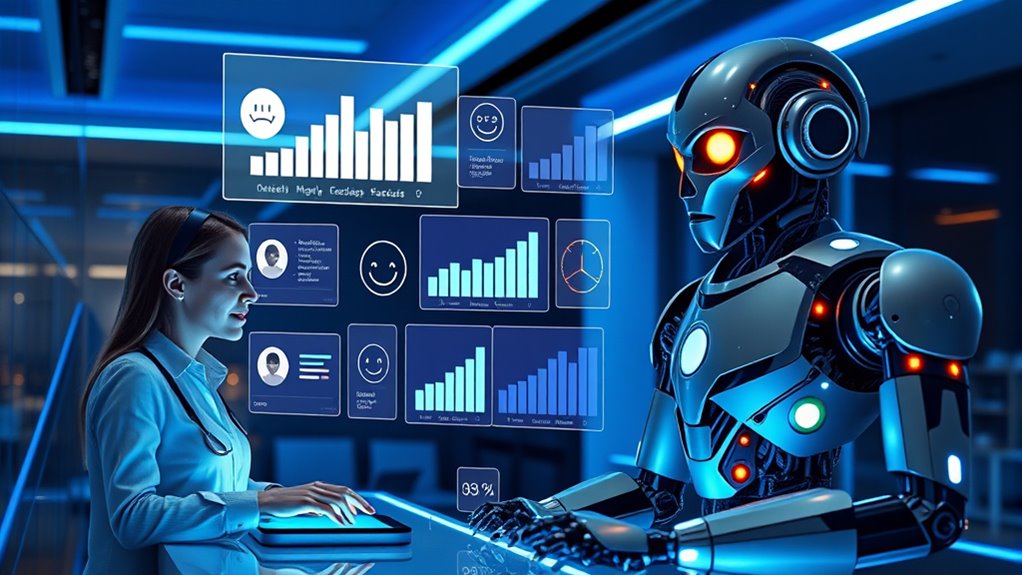In hybrid customer service teams, humans handle complex, emotionally charged issues while AI manages routine inquiries, leading to faster, more personalized support. AI reduces response times and operational costs, freeing agents for relationship-building tasks. This blend improves customer satisfaction and efficiency, yet requires careful integration and transparent workflows to build trust. If you want to see how these systems evolve and shape the future of support, there’s more to explore ahead.
Key Takeaways
- Hybrid teams combine AI efficiency with human empathy to enhance customer service quality and personalization.
- AI handles routine inquiries, freeing humans for complex, emotionally charged issues.
- Seamless human-AI collaboration reduces response and resolution times significantly.
- Hybrid models improve operational costs, scalability, and support proactive customer needs.
- Trust and transparency are vital for effective man-machine integration in customer service.
The Rise of Hybrid Customer Service Models

The rise of hybrid customer service models reflects a strategic shift toward combining artificial intelligence with human expertise to better meet customer needs. You’ll find AI handles routine inquiries and repetitive tasks, freeing human agents to focus on complex, emotionally sensitive issues. AI also provides detailed interaction histories and context, making human interactions more efficient. Customers prefer speaking with humans when facing complicated or emotionally charged problems, which underscores the importance of human involvement. These models aim to deliver both efficiency and empathy, ensuring customers receive personalized, seamless support. As technology advances, more companies adopt hybrid approaches, recognizing that combining AI’s speed with human understanding creates a balanced, effective customer service experience. This shift signifies a new era of smarter, more responsive customer support. Additionally, understanding regional resources can help organizations better tailor their hybrid models to local customer preferences, including local store hours that influence customer interaction patterns. Incorporating GMC tuning techniques can further optimize support tools and enhance overall customer satisfaction. Furthermore, integrating prophetic dreams insights can inspire innovative strategies to improve customer engagement and service delivery. Moreover, leveraging knowledge of scams can help companies educate customers and protect their brand reputation within these hybrid models.
Combining Strengths: AI and Human Agents

Combining the strengths of AI and human agents creates a powerful synergy that enhances customer service. AI handles routine tasks efficiently, reducing first response times by up to 37% and resolution times by up to 52%, while cutting costs by half per call. This allows human agents to focus on complex issues, supported by AI-driven insights, suggested responses, and sentiment analysis that improve productivity and decision-making. AI also automates up to 70% of contacts, boosting agent efficiency by about 1.2 hours daily. Customers report positive experiences—around 80% feel satisfied with AI-powered service—and many believe AI can be empathetic. Nearly 50% of customers believe AI agents can demonstrate empathy in addressing concerns. Additionally, integrating projector technology principles, such as high contrast ratios and color accuracy, can inspire innovative customer service solutions that enhance visual communication. Understanding the divorce process in different states helps businesses tailor solutions for diverse customer needs. Furthermore, leveraging AI content clusters can help organizations develop targeted knowledge bases that improve support quality and consistency. Incorporating Honda Tuning insights, such as suspension and engine modifications, can also inspire creative approaches to support infrastructure and tools. Incorporating anime movies into training modules can also boost engagement and creativity among support teams. Together, AI and humans create faster, more cost-effective support that meets customer expectations and prepares businesses for future growth.
Enhancing Customer Experience With Hybrid Teams

You can enhance customer experience by implementing personalized interaction strategies that tailor support to individual needs. Efficient issue resolution becomes possible when automation handles routine tasks, freeing human agents for complex problems. Building emotional connections through empathetic, human-led interactions creates loyalty and trust that digital channels alone can’t achieve. Recent research shows that hybrid teams maintain productivity and foster better customer relationships when managed effectively. Additionally, leveraging local tips can help teams better understand customer preferences and regional nuances, further improving service quality. Incorporating multichannel communication strategies ensures that customer engagement remains seamless across various platforms, strengthening overall satisfaction. Furthermore, integrating sound healing science principles into team well-being practices can reduce stress and improve focus among staff, ultimately enhancing the quality of customer interactions. Recognizing the importance of quality assurance can help teams identify areas for improvement and ensure consistent service standards. Emphasizing employee well-being through holistic approaches can lead to more engaged and effective customer service representatives.
Personalized Interaction Strategies
How can hybrid teams effectively deliver personalized customer interactions that boost satisfaction and loyalty? First, leverage data collection, like purchase history and past interactions, to understand individual preferences. Use AI tools to analyze this data, enabling tailored recommendations and targeted content across channels such as email, chat, and social media. Human agents bring empathy and responsiveness, making interactions feel genuine and customized. Combining automation with personal touch ensures routine issues are handled efficiently, freeing your team to focus on complex, emotionally nuanced situations. Additionally, integrating personalization strategies acts as a force multiplier for business growth, and consistent delivery in this area builds trust and strengthens relationships. Incorporating AI-driven insights can further optimize engagement strategies by providing real-time feedback and predictive analytics. Moreover, understanding the Louisiana alimony laws helps ensure that support is tailored appropriately and legally, complementing your customer service approach. Recognizing the importance of personality compatibility can enhance team dynamics and improve overall service quality. By integrating technology and human insight, your hybrid team can create a seamless, relevant customer journey that not only meets expectations but exceeds them, fostering loyalty and encouraging long-term engagement. Additionally, adopting effective communication techniques can help bridge potential gaps between automated responses and human interactions, ensuring consistency and clarity throughout the customer experience.
Efficient Issue Resolution
Hybrid teams excel at delivering efficient issue resolution by leveraging the strengths of both AI and human agents. AI handles routine inquiries quickly, reducing wait times and automating triage to direct complex issues to human agents. With 24/7 AI-powered chatbots, customers get immediate acknowledgment, while machine learning continually improves response accuracy. This reduces agent workload, allowing human agents to focus on high-value, nuanced problems requiring empathy and judgment. Collaboration between AI and humans is seamless, with real-time data support and smooth escalation protocols. Feedback from human agents helps refine AI performance. Additionally, integrating the best heat pump technology into customer service solutions can further enhance efficiency by providing tailored recommendations based on environmental data. Implementing automated issue detection can help identify recurring problems early, preventing escalation and improving overall service quality. Recognizing the importance of empathy in customer interactions ensures that human agents can effectively address complex emotional needs. As a result, hybrid teams boost productivity—up to 62% higher—and cut costs markedly. This efficient approach ensures faster resolution, leading to a better customer experience overall.
Emotional Connection Building
Building emotional connections is essential for creating memorable customer experiences, and hybrid teams are uniquely positioned to achieve this at scale. By combining human empathy with AI tools, you can personalize interactions based on customer data, preferences, and emotional cues. Human agents handle complex emotional signals and build genuine relationships, while AI manages routine queries and provides real-time sentiment analysis to guide responses. Celebrating milestones and personalizing communication deepen bonds beyond transactions. Emotional marketing and storytelling foster relatability, strengthening loyalty. Hybrid teams also support social causes and community-building efforts, creating shared values that resonate emotionally. Incorporating personalized communication strategies enhances the impact of these efforts. This integrated approach helps you foster stronger customer relationships, reduce churn, and turn satisfied customers into loyal advocates, all while delivering consistent, emotionally engaging experiences across channels. Utilizing free online tools to convert text into various capitalization styles can enhance communication clarity and branding consistency. Additionally, recognizing relationship dynamics within your team can improve collaboration and overall service quality.
Operational Benefits and Cost Savings

Implementing a hybrid team structure offers significant operational benefits and cost savings that can boost your customer service efficiency. You gain scalability without expanding physical space, making it easier to hire remote talent across various locations and time zones. This model ensures consistent coverage, improving customer experience and response times. Employees enjoy flexible work environments, increasing engagement and productivity. Cost savings come from reduced office expenses, lower commute costs, and minimized infrastructure needs, allowing you to allocate resources more effectively. Scaling operations becomes more affordable, with less reliance on physical assets. Additionally, access to a broader talent pool enhances your ability to find skilled agents quickly. Overall, hybrid teams streamline operations, cut costs, and elevate service quality, giving you a competitive edge in today’s fast-paced customer landscape.
Navigating Challenges in Integration and Training

Guiding the challenges of integrating technology and training in a hybrid customer service environment requires careful planning and proactive management. Communication gaps between remote and in-office agents can cause misunderstandings and slow responses, impacting service quality. Without immediate feedback, customer wait times increase, and issue resolution slows down. Disparities in using communication tools fragment team messaging and knowledge sharing. Coordinating schedules during peak hours complicates collaboration, while digital fatigue demands balancing synchronous and asynchronous communication to keep agents engaged. Training must adapt, combining virtual and in-person methods, and include simulations for AI-human interactions. Continuous learning platforms update agents on evolving tools and AI capabilities. Ensuring equal access to resources and seamless software integration is essential to maintain performance, cohesion, and confidence across all team members.
The Role of Emotional Intelligence in Customer Support

Emotional intelligence plays an essential role in delivering exceptional customer support, especially in a hybrid team environment. When you understand and respond to customer emotions, you create personalized experiences that meet individual needs. Customers are willing to pay more for quality service, and positive emotions during interactions can increase their likelihood to purchase by 40%. Conversely, negative experiences risk losing customers—up to 92% after multiple poor interactions. Fully connected customers, who feel emotionally linked to a brand, are up to 52% more valuable. Incorporating emotional intelligence into training programs helps build trust and loyalty. In hybrid teams, human empathy complements machine efficiency, enabling you to better handle complex situations and foster stronger emotional connections, ultimately boosting customer satisfaction and retention.
Trends Shaping Hybrid Teams in 2025

In 2025, you’ll see hybrid teams increasingly rely on AI to boost support efficiency and personalize interactions. Human agents will work alongside AI, handling complex issues and managing proactive service strategies. These trends are transforming customer service by making teams more agile, responsive, and customer-focused.
AI-Enhanced Support Strategies
AI-enhanced support strategies are transforming how hybrid customer service teams operate in 2025 by boosting efficiency, reducing costs, and improving customer satisfaction. AI can cut resolution times by up to 52%, freeing agents to handle more complex issues. It also reduces operational costs by up to 68%, especially during peak seasons. Automation boosts customer engagement, increasing repeat purchases by 36%, and speeds up responses with a 37% reduction in first reply times. Autonomous AI agents now handle 80% of inquiries, streamlining workflows and decreasing resolution times. Predictive analytics enable proactive support by anticipating customer needs, offering personalized solutions, and preventing issues before they escalate. These strategies create a seamless, efficient customer experience, empowering hybrid teams to deliver swift, tailored support while controlling costs.
Human-AI Collaboration Growth
By 2025, human-AI collaboration is reshaping how hybrid customer service teams operate, combining automation with human insight to deliver superior support. AI is expected to handle 95% of customer interactions, including voice and text, freeing human agents for complex challenges. Hybrid models blend AI’s efficiency with human empathy, ensuring seamless transitions and better customer experiences. Strategic AI investments are essential to maximize this collaboration, allowing AI to detect frustration and escalate issues when needed. As automation handles routine tasks, human skills like empathy and creativity become more valuable. AI provides agents with detailed interaction histories, supporting informed decisions. This synergy builds trust and loyalty, making human-AI collaboration a core trend that will define customer service in 2025.
Proactive Service Adoption
Proactive service adoption is transforming how hybrid customer service teams operate in 2025, with AI-driven analytics enabling providers to anticipate and address customer needs before issues arise. You’ll see advanced AI systems analyzing customer behavior and historical data, allowing personalized solutions and proactive interactions that boost loyalty. Businesses can now reach out with solutions before problems escalate, such as notifying customers about upcoming deadlines or optimization tips. This shift improves efficiency and fosters stronger relationships. Emerging trends include agentic AI handling complex requests autonomously, AI-powered chatbots empowering customers to resolve issues independently, and predictive maintenance reducing downtime. Companies leveraging data analysis and AI tools gain a competitive edge, increase customer satisfaction—up by 24%—and set new standards for proactive, personalized service in hybrid teams.
Measuring Success: Metrics and Customer Satisfaction

Measuring success in hybrid customer service teams involves tracking key metrics that reflect both operational efficiency and customer satisfaction. These metrics help you understand how well your AI-human collaboration is performing. For example, monitoring average resolution time and handle time reveals how quickly issues are resolved. Customer churn rate and Customer Effort Score (CES) highlight loyalty and ease of support. Use the table below to see how these metrics connect to customer satisfaction and operational success:
| Metric | Purpose |
|---|---|
| Average resolution time | Measures support speed and efficiency |
| Customer churn rate | Indicates loyalty and retention |
| CES | Gauges ease of getting help |
| Handle time | Tracks total time from contact to resolution |
Future Innovations in Human-AI Collaboration

Advancements in human-AI collaboration are shaping the future of customer service by enhancing how teams work together. AI will take on routine tasks, freeing you to handle complex issues that require creativity and empathy. Real-time suggestions and relevant data from AI tools will help you respond faster and more accurately, boosting efficiency. Emerging technologies like conversational chatbots and NLP-powered virtual agents will become more sophisticated, enabling smoother, context-aware interactions. By 2025, the chatbot market will surpass $1.34 billion, indicating rapid growth. These innovations will support personalized, human-like experiences while automating high-volume tasks. As AI evolves, your ability to leverage these tools will be key to delivering faster, more effective service, all while maintaining the human touch that builds lasting customer relationships.
Building Trust and Transparency in Hybrid Environments

Building trust starts with clear communication about roles and expectations, so everyone knows their responsibilities. Transparency in how AI tools are used reassures team members and fosters confidence. When you prioritize open dialogue, you create a culture of honesty that strengthens hybrid teamwork.
Clear Role Communication
Clear role communication is essential for fostering trust and transparency in hybrid customer service teams. When everyone understands their responsibilities, confusion and overlap are minimized. Define each role clearly, whether human or machine, so team members know what to expect and how to collaborate effectively. Use communication strategies that keep everyone informed about changes or updates to roles, ensuring smooth operations. Regular feedback from customers and team members helps identify gaps or misunderstandings, allowing quick adjustments. Promoting transparency about who handles specific tasks builds confidence in the team’s capabilities. By establishing clear expectations and open communication channels, you create a cohesive environment where both human agents and AI systems work seamlessly together, strengthening trust and boosting overall service quality.
Transparency in AI Use
Effective role communication sets the foundation for smooth collaboration in hybrid customer service teams, but transparency around AI use is equally essential for fostering trust. When you openly disclose how AI contributes to service, you build confidence with your customers. Over 80% of consumers want clear labels on AI-generated content, and 62% say transparency boosts their trust in brands. Being upfront about AI’s role helps customers make informed decisions and feel more comfortable. It also demonstrates ethical practices and accountability. To succeed, consider these strategies:
- Clearly label AI-generated content to set expectations.
- Provide insights into how AI makes decisions.
- Educate customers about AI’s role in service interactions.
Frequently Asked Questions
How Do Hybrid Teams Ensure Consistent Service Quality Across Channels?
You guarantee consistent service quality across channels by clearly defining roles for both humans and AI, so each handles tasks suited to their strengths. You leverage AI to automate routine work and provide data insights, helping human agents deliver personalized, empathetic support. Regular training and feedback loops help refine processes, while seamless integration across platforms guarantees a unified experience. Monitoring performance metrics keeps your team aligned and consistently high-performing.
What Strategies Improve Collaboration Between AI and Human Agents?
To improve collaboration between AI and human agents, you should establish clear roles, foster open communication, and provide ongoing training. You need to define responsibilities, encourage feedback, and promote mutual understanding. You want to leverage AI’s speed and data insights while valuing human empathy and problem-solving skills. You aim to create a seamless workflow, optimize interactions, and build trust, ultimately enhancing customer satisfaction and operational efficiency through effective teamwork.
How Is Customer Privacy Maintained in Ai-Human Hybrid Interactions?
You keep customer privacy secure in AI-human hybrid interactions by implementing strict data encryption, anonymization, and secure access controls. You inform customers clearly about data handling, obtain their explicit consent, and give options to opt out. You also rely on AI to handle routine data while human agents access only necessary information, supported by regular audits and monitoring to prevent breaches and ensure compliance with privacy laws.
What Are Effective Ways to Train Employees for Hybrid Customer Support?
You’re about to revolutionize your customer support training! Combine in-person workshops with virtual modules to slash training time dramatically and boost retention by 35%. Use VR simulations and live role-plays to make learning unforgettable. Personalize training for diverse learning styles, pair tech-savvy hires with veterans, and continuously measure results. This dynamic approach will supercharge your team’s skills, engagement, and confidence—making your customer service unbeatable in the hybrid world.
How Do Hybrid Teams Adapt to Rapidly Evolving Customer Expectations?
You adapt to evolving customer expectations by leveraging hybrid teams that combine AI’s speed and efficiency with human empathy and emotional intelligence. Use AI insights to personalize interactions and anticipate needs proactively. Continuously gather feedback, refine processes, and invest in training so your team remains agile. This approach ensures faster resolutions, higher satisfaction, and seamless service, all while maintaining the human touch where it matters most.
Conclusion
As you navigate the evolving landscape of customer service, remember that hybrid teams are like a symphony—blending human intuition with AI precision to create harmony. Embrace the rhythm of innovation and trust, for this partnership is the brushstroke painting a brighter, more responsive future. By mastering the dance between man and machine, you’ll craft an experience where technology enhances warmth, and trust becomes the melody that resonates long after the call ends.









